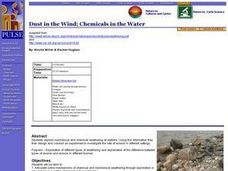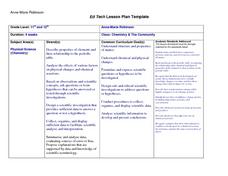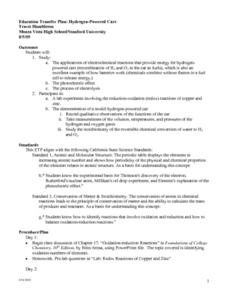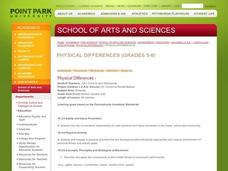Curated OER
Blame It On El Nino
Students understand what the weather phenomenon El Nino is and what causes it. Students recognize how remote sensing technology can detect and predict El Nino. Students discover how El Nino effects weather conditions throughout the globe...
Curated OER
Dust in the Wind; Chemicals in the Water
Students explore mechanical and chemical weathering at stations. They articulate some mechanisms of chemical and mechanical weathering through exploration in a lab. Students stations describe how chemical weathering differs from...
Curated OER
Chemical Equations and Symbols
In this chemical equations and symbols worksheet, students are given two written equations and they translate each into chemical symbols. They are given two equations with chemical symbols and they translate them into written equations.
Curated OER
Chemistry & The Community
Young scholars complete a Webquest which investigates the chemistry in items such as shampoo. They research the Internet, perform a lab experiment, and write a scientific lab report with their findings. Upon completion of the activities,...
Curated OER
Water Cycle
Ninth graders explore ways water moves through various reservoirs on Earth, examine how human activities change water cycle, investigate substances present in water that indicate human activity, and discuss how understanding water cycle...
Curated OER
Walking For Water
Students investigate how third world countries get their water. In this water lesson, students research how countries like Kenya and Ethiopia get their water supply. Students participate in an experiment to role play how difficult it is...
Curated OER
Introducing Biodiversity
Young scholars identify the basic components necessary for biodiversity, the critical and countless benefits of habitats, as well as the serious present and future threats to their ongoing existence.
Curated OER
Dinosaurs 1: Where Are the Dinosaurs?
Students study dinosaurs. In this dinosaur instructional activity, students watch a web based video about dinosaurs before discussing what they liked about the dinosaurs, telling about the sounds they heard, and explaining what the Earth...
Curated OER
Atoms, Kinetic Theory, Solids and Fluids
Students identify and describe the building blocks that make up an atom. They also compare the ages of atoms to the ages of the materials they compose,as well as, give examples that illustrate the small size of atoms.
Curated OER
Microclimates of Our School
Students read the story "Weslandia" by Paul Fleischman, define the term microclimate, gather and record data in various places on school grounds to establish the presence of difference microclimates, analyze and compare microclimates,...
Curated OER
Bowen's Reaction Serives: Magma Differentiation
Students investigate the differentiation of magma to form different minerals present in a rock. By using the model proposed by Bowen, they determine the depth, temperature, and composition of magma. Students explain why some minerals...
Curated OER
Global Water Crisis
Students research a given nation and complete an activity chart for that country. In this water crisis lesson plan students work in groups to organize and present the information for their given country.
Curated OER
Life in a Cup
Third graders make and maintain a mini terrarium. They keep a daily journal of what happens in their terrarium and record daily observations and measurements.
Curated OER
Hydrogen Powered Cars
Learners apply the principles of chemistry to investigate the concept of how a hydrogen powered car works. They study the electrochemical reactions that provide the energy source. Students also record observations in the functioning of a...
Curated OER
Volume of Gas
Eighth graders investigate the effect of temperature on the volume of a gas in a closed container. They measure the height of the water in their beaker/container, conduct their experiment, and create a graph to illustrate their data.
Curated OER
Properties of Materials - Part B
Students describe the history of materials. They use the kinetic (particle) theory to explain changes of state in matter and trace the flow of heat during changes of state and chemical changes.
Curated OER
The Dalton Model
In this Dalton worksheet, students read about John Dalton and his contributions to understanding the atom. Students are given sample data for Dalton's experiments and they answer questions about the data in his experiments.
Curated OER
The Halogens
In this chemistry worksheet, students answer 24 questions related to properties of halogens. They fill in the table with the correct answers and participate in teacher demo.
Curated OER
What is a Chemical Reaction?-Evidence of Change
In this chemical reactions worksheet, students experiment with hydrochloric acid and copper (I) chloride to identify the types of reactions they undergo with various other substances. They also observe the law of conservation of mass and...
Curated OER
Diversity
Students access prior knowledge of the five senses and relate to students with disabilities. In this people with disabilities lesson, students research and use a Venn diagram to compare and contrast famous people and their...
Curated OER
Animals, Animals, Everywhere
Fourth graders participate in a variety of activities dealing with animal characteristics and classifications in this multi-task activity. They use graphic organizers, make booklets, and make models.
Curated OER
Inside an Atom
In this atom worksheet, students read about the history of the discovery of the atom. Students write a story, poem, song or other creative project in which they shrink to an incredibly small size and are trapped in a carbon atom.
Curated OER
The Mole
Students investigate moles and Avogadro's hypothesis. For this moles lesson plan, students complete a worksheet by finding the volume of 1 mole of each substance given its density and they find the number of molecules, the formula, the...
Curated OER
Capacitive Reactance
In this electronics worksheet, students solve and write short answers to 15 questions about capacitors. They interpret schematic diagrams and calculate values using Ohm's law.























